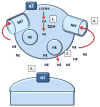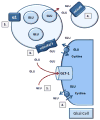Pharmacotherapeutics directed at deficiencies associated with cocaine dependence: focus on dopamine, norepinephrine and glutamate
- PMID: 22327234
- PMCID: PMC3341931
- DOI: 10.1016/j.pharmthera.2012.01.010
Pharmacotherapeutics directed at deficiencies associated with cocaine dependence: focus on dopamine, norepinephrine and glutamate
Abstract
Much effort has been devoted to research focused on pharmacotherapies for cocaine dependence yet there are no FDA-approved medications for this brain disease. Preclinical models have been essential to defining the central and peripheral effects produced by cocaine. Recent evidence suggests that cocaine exerts its reinforcing effects by acting on multiple neurotransmitter systems within mesocorticolimibic circuitry. Imaging studies in cocaine-dependent individuals have identified deficiencies in dopaminergic signaling primarily localized to corticolimbic areas. In addition to dysregulated striatal dopamine, norepinephrine and glutamate are also altered in cocaine dependence. In this review, we present these brain abnormalities as therapeutic targets for the treatment of cocaine dependence. We then survey promising medications that exert their therapeutic effects by presumably ameliorating these brain deficiencies. Correcting neurochemical deficits in cocaine-dependent individuals improves memory and impulse control, and reduces drug craving that may decrease cocaine use. We hypothesize that using medications aimed at reversing known neurochemical imbalances is likely to be more productive than current approaches. This view is also consistent with treatment paradigms used in neuropsychiatry and general medicine.
Copyright © 2012 Elsevier Inc. All rights reserved.
Figures



References
-
- Adewale AS, Platt DM, Spealman RD. Pharmacological stimulation of group ii metabotropic glutamate receptors reduces cocaine self-administration and cocaine-induced reinstatement of drug seeking in squirrel monkeys. J Pharmacol Exp Ther. 2006;318(2):922–931. doi: 10.1124/jpet.106.105387. - DOI - PubMed
-
- Ahmed SH, Koob GF. Cocaine- but not food-seeking behavior is reinstated by stress after extinction. Psychopharmacology (Berl) 1997;132(3):289–295. - PubMed
-
- Amadoe &, Gazdar A. Sudden death durin disulfiram — alcohol reaction. Q J Stud Alcohol. 1967;28(4):649–654. - PubMed
Publication types
MeSH terms
Substances
Grants and funding
LinkOut - more resources
Full Text Sources
Other Literature Sources
Medical

